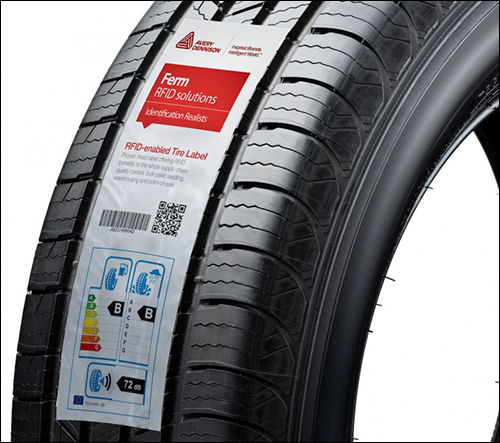Mar 10, 2017Netherlands-based technology company Ferm RFID Solutions is releasing an upgraded version of an adhesive tread label that it offers to tire producers, which serves as a universal ultrahigh-frequency (UHF) RFID tag with a read range of approximately 8 meters (26.2 feet) on all kinds of tires. The tags can be read in bulk, even in environments such as stacked tires on metal racks.
The tire tread labels are already in use by tire companies that sell products in the United Arab Emirates (UAE) to enable the tracking of tires that enter the country. The UAE government requires that all tires sold within that nation be tracked through the supply chain via RFID labels. For more than a year, tire companies who export products to the Emirates have been applying the Ferm RFID labels. Most recently, however, the firm has upgraded the RFID labels, using its own copper antenna design to create an optimal read range—no matter the material, size and type of the tire or the orientation of the tag.
Ferm RFID Solutions created the RFID antenna in partnership with Smart Res (which helped design the inlay and antenna) and Avery Dennison Material Group Europe (which developed the materials and adhesives that enable the tag to be affixed to the surface of a tire with nearly 100 percent reliability), says Jos Uijlenbroek, Ferm RFID's co-founder.
The tagging of tires is often a process that starts with the tires' manufacture. Ferm RFID and other technology companies offer RFID tags that can be built into a tire (typically in its sidewall) during manufacturing, in a process known as vulcanizing. Because the tag is embedded in the tire, it enables companies to follow that tire through production logistics and its entire life cycle, including when it is in use on a vehicle. That ability to automate tire tracking has recently been in greater demand, Uijlenbroek says, to provide added services to fleet managers and other stakeholders. Tire manufacturers are focusing more on providing tires as a service, rather than just as a product—identifying how tires are being used and for how long, and providing the necessary maintenance or service.
However, the company notes, there are some applications for which the embedded tire tags do not work well. For instance, because each tag is embedded in a tire's sidewall, tags can become difficult to read when stacked side by side on racks (a common orientation for tires in the supply chain). They also are hard to read in bulk, such as identifying a large number of tagged tires entering or leaving a warehouse using a fixed or handheld reader.
For that reason, Uijlenbroek explains, tire companies are opting for the Ferm RFID adhesive tire tread label that can be easily read in the logistics environment. The label can be affixed directly to the tire's tread, and is designed to remain on that tire until it is sold, at which point the customer or retailer can simply remove it. The RFID tread label can be printed in the form factor of common brand labels already used by manufacturers.
Tires present one of the most difficult labeling challenges, says Hans Eichenwald, Avery Dennison Materials Group Europe's senior product manager. "They have so-called low surface energy," he explains, "because of which it is hard for labels to stick to." The rough surface of the tread makes that even more difficult. In addition, he says "They contain components that can migrate and cause staining and swelling." The effect could make the label curl away from the tire over time. What's more, the labels had to be able to withstand extreme temperatures and humidity in the supply chain. Tire labels with aluminum barrier layers cannot be used either, due to interference with RFID reading.
Avery Dennison Material Group Europe has developed materials to operate well with these challenges. "We have tested these label materials extensively with inlays in climate rooms," Eichenwald says. In such rooms, he adds, "we ran temperature and humidity cycles with our labels on tires that mimic real-life performance in the supply chain. From the work done, we can conclude that specifically our [polypropylene] tire label materials and our PET—polyesters—materials are working very well."
The new RFID tread label technology allows bulk reading of up to 150 tires simultaneously, as they move through a reader gate, at a distance of up to 8 meters. This, Uijlenbroek says, is enabled by an RFID antenna that has been designed so it cannot be disconnected from the RFID chip. Avery Dennison's proprietary tire label adhesive ensures that the tags remain on the tread to which they are attached. Eichenwald adds that tire adherence and performance is critical since a missing label means the tire could be lost from the system.
The challenge for Ferm RFID Solutions has been to develop a tag that can read RF signals and transmit on any tire. Tags that work only on certain tires have limited value, Uijlenbroek says. Since there are many different kinds of tires composed of rubber, steel, carbon black and other materials, the company spent several years developing a tag that could be reliably read on every tire—even solid rubber tires used on large cranes. "A tire producer wants a one-size-fits-all label," he states.
The tread tire label can be used to help companies ensure that tires are sold to customers before they reach their expiration date, while also making supply chain management more automated. Typically, the tags are read at the points of shipping and receiving, as well as for stock counting, order picking and proof of delivery to a customer. Uijlenbroek adds that the tags can be interrogated via a forklift reader even when tires are stacked on racks or pallets.
In the case of the United Arab Emirates, labels are thus far being attached to tires as they enter the country. In the future, tire manufacturers may apply the labels before they leave the manufacturing point of origin.
According to Uijlenbroek, most large tire producers are testing Ferm RFID's vulcanized labels on some of their products. But in many cases, the companies defined the use cases for both the tire tread and vulcanized labels for the applications they provide.



